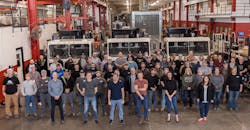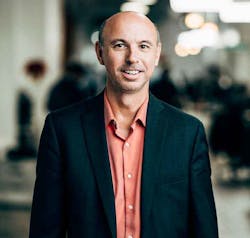The drumbeat is that legacy manufacturing companies need to become more like tech companies, but that cadence can go both directions. Tech startups increasingly see power in tooling, machining and process expertise. What do they gain from relationships with legacy manufacturing? Production footprint and know-how and a deeper understanding of supply chains and the customer. Not to mention more oversight and a stronger financial stake in the end result.
Add Battle Motors to that list of startups with a vested interest in manufacturing: The Los Angeles EV tech firm earlier this year* acquired Crane Carrier, a 75-year-old, 200-employee manufacturer of vocational trucks (think garbage trucks, city service and recycling vehicles) in New Philadelphia, Ohio. Battle Motors’ chief technology officer, Nick Sampson, co-founder of Faraday Future and former head of vehicle engineering at Tesla, talked with IndustryWeek about the advantages of OEM ownership and integrating tech and manufacturing.
Why the move from luxury cars to garbage trucks and earth movers?
When I left [Faraday Future], I looked around at the world of industry in general, and future opportunities. As well as moving people in the future using alternative fuels, there's a hell of a lot of stuff that the world moves around and an equally huge need for moving that stuff, from your pizza being delivered down the street, to large items being shipped all over the world, to refuse being picked up from your back door. That whole huge arena is just as important to make an impact in.
I look at sustainability in two areas: the area of lower emissions and cleaning up greenhouse gases—and the other side, that the oil [supply] isn’t going to last forever. We need to find alternative ways of powering our vehicles and our ways of life. The transport sector is as important [as electric cars] in those two areas, if not more important. If we really want to improve the environment, in terms of greenhouse gases, or we want to move to more sustainable forms of energy, then we need to solve the issues for the transport sector just as much as the mobility sector.
When I was at Tesla, we helped start some of the change in the mobility sector. And now more and more both startups and mainstream manufacturers are realizing that we need to make electric cars in the future but the transport sector seems to be lagging behind badly in every sector, whether that be last-mile delivery to all the utility requirements within cities to long-distance haulage.
Battle Motors' CTO Nick Sampson
Your plans call for your first vehicles to hit the market in the second half of 2021. Where are you with the manufacturing of them?
The manufacturing component is a clear challenge for many of the startup organizations in the EV space. It's one thing to make a pretty-looking prototype. It's another thing to be able to produce things in volume and build factories and facilities and all that it takes to be in volume production. That that is a huge, huge challenge underestimated by many—even Tesla has taken, well, nearly 10 years now. So many startups that think they're going to go from building a prototype to being involved in production. It's a big challenge. So, that was one of the opportunities that [Battle CEO and veteran of battery storage startup Romeo Power] Mike Patterson saw, with Crane Carrier, that here was an opportunity to acquire a company that already had good manufacturing capability and facilities, had a service and sales infrastructure that already existed. And sales channels and existing customers—all of the elements that are taking time, effort and energy to put into place. And bringing together technology and innovation from California—the background of Mike in the batteries and (Chief Software Officer) Paul (Marsolan) in technology and software and myself in electric vehicles—and combining that with the strong tradition of an existing company that has already got manufacturing capability and a facility. It accelerates our ability to get a product into the marketplace.
What's the plan, exactly, as far production of the mix of diesel-powered trucks and EVS, with the manufacturing facility that you’ve acquired?
Currently they’re producing all diesel-powered vehicles as well as a few CNG diesels. We are already working to convert lines and expand the factory capacity to be able to produce both battery electric vehicles as well as the existing diesel and CNG vehicles.
You also have plans to double to triple the footprint at Crane. What's the timeline for the expansion?
We’re pushing fairly hard at the moment, against the biggest limitations that are coming up. The last couple of years or the last year or so has had a horrendous impact on whole supply chain, whether it be you're trying to buy components for the vehicles or you're trying to buy steel for the building. Everything is limited by the availability of getting things into place. So we're just we're pushing as fast as we can against that backdrop. As things open up, hopefully we’ll be able to accelerate—as more people get back to full time work and more production capability comes online worldwide.
What training will the existing Crane workforce need, and do you see your workforce growing?
We except a fairly dramatic growth over the next few years in the workforce here. We're working with Jobs Ohio to look at ways of doing that and providing development training and skills transfers that are needed for people to move into this industry—and even people that aren’t currently here to learn new skills of building battery electric vehicles as opposed to internal combustion vehicles. Let's define different skill sets needed in certain key areas and put into place the relevant training schemes and plans.
What have you learned from Tesla and Faraday about leadership and getting the manufacturing done that you're bringing with you to Battle Motors?
I think as time moves on, that traditional knowledge and understanding and ways of going about it needs to be blended with the faster startup-type environment. We want to capture the best of both worlds with the type of organization we were putting together as Battle Motors in California, and combining and building on that with the heritage of a company like Crane in Ohio. That gives us a great competitive advantage—being able to build on the best of the traditional knowledge and methodology with the fast-paced, innovative approach of a new organization, and be able to get into production and produce the new creative products in a faster timeframe than we would be able to if we were just trying to do it alone.
Will the more traditional manufacturing skills translate to electric?
Yes, many elements do. Many elements of the vehicle are still the same: It's still a vehicle, it still needs to have certain performance and quality requirements, and people who have been doing those elements can bring great knowledge to the process moving forward. Yes, we do need to adapt and blend, but electric vehicles aren't that different. There are still many, many elements that need to be done in the same sorts of ways. And the same sorts of processes need to be applied to ensure the consistency and quality that the traditional vehicles have had for many, many years. That’s particularly true when we get into these harsh environments. It’s less about the emotional elements or whims of the customer—the feel of the seats, the look of the leather—and more about can I save 10 cents off the cost per mile?
And that's why in this sector, I think we can make some great gains with the battery electric vehicle by actually being able to provide better products, better suited to things, and that it comes down often to lifetime cost as opposed to immediate cost. It is a sector that can more look at that consideration, as opposed to the consumer sector where, you know, the actual price of the car off the lot had the emotional elements of buying it. As opposed to, how much is it gonna cost to deliver this stuff over the next five years, or collect trash over the next five years. It's being measured in a very different way.
Personal observation and question to close this out: I live in an older city and the streets are narrow—the garbage trucks have a heck of a time getting through. Are you looking at smaller vocational vehicles as well?
Carrier actually has two primary products. One that has been used in the refuse market, and another that they have been producing fairly recently. So there’s the LET chassis, which is currently used a lot in the refuse market. But they have been recently producing something called the LNT, which is about a foot narrower than the LET. It's very similar-looking, but narrower and generally single rear axle rather than twin rear axle. So a sort of gross load of more like 33,000 pounds instead of 70,000. And we'll simultaneously be electrifying those to meet the need of smaller, narrower streets markets that actually became city centers and, you know, it's obviously the gonna be the cities that drive this need for battery electric vehicles, perhaps more than those more suburban routes.
Got a manufacturing candidate for Profiles in Leadership? Contact Senior Editor Laura Putre.*A press release from Battle Motors misstated that Crane Carrier had been acquired in April. The timeline in the article has been corrected.
Main photo: The Crane Carrier workforce gathers in the plant with new leadership.About the Author

Laura Putre
Senior Editor, IndustryWeek
As senior editor, Laura Putre works with IndustryWeek's editorial contributors and reports on leadership and the automotive industry as they relate to manufacturing. She joined IndustryWeek in 2015 as a staff writer covering workforce issues.
Prior to IndustryWeek, Laura reported on the healthcare industry and covered local news. She was the editor of the Chicago Journal and a staff writer for Cleveland Scene. Her national bylines include The Guardian, Slate, Pacific-Standard and The Root.
Laura was a National Press Foundation fellow in 2022.
Got a story idea? Reach out to Laura at [email protected]


